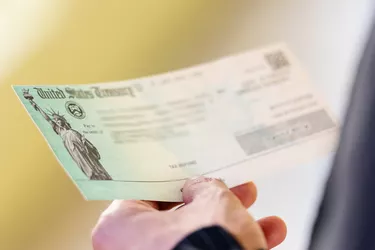
The U.S. federal government makes payments to taxpayers and other beneficiaries with a United States Treasury check. IRS refunds and benefit payments from the Social Security Administration, Veterans Administration and several other agencies are issued in this form. To fight counterfeiting and fraud, the checks are designed with several security features that verify authenticity. In addition, the U.S. Treasury provides an online verification system to support financial institutions that accept the checks as deposits. The verification system is also available to the general public.
Tip
Use the United States Treasury online verification system to verify a U. S. Treasury check.
Video of the Day
U.S. Treasury Check Watermark
The most distinguishing security feature of a Treasury check is its watermark. Each check is printed on paper that has faint text reading "U.S. TREASURY" visible from both the front and the back when the check is held up to the light. The watermark is very faint and won't copy, so any check that looks like a U.S. Treasury check but does not have a watermark is suspect.
Video of the Day
Other Treasury Check Security Features
Besides the distinctive watermark, U.S. Treasury checks have several other physical security features that fight counterfeiting, including:
- Bleeding ink. On the front of some Treasury checks, the seal of the U.S. Treasury is printed in black to the right of the image of the Statue of Liberty. The seal will bleed red ink if moisture is applied, a feature that cannot be duplicated with a copier.
- Microprinting. This type of printing is so small that it appears as a straight line to the unaided human eye but can be viewed with a magnifying glass, making it impossible to duplicate with a copier. Microprinting appears in three areas on a Treasury check.
- Ultraviolet overprinting. As a final security check, an ultraviolet pattern that can only be viewed with a black light device is printed under the amount box on the check. Altering the figure in the amount box will affect the ultraviolet image and indicate the check was tampered with.
Treasury Check Information System (TCIS)
The U.S. Department of the Treasury provides a website for Treasury check verification. The website accesses the Treasury Check Information System (TCIS). You'll need to enter the check number from the upper right corner of the check and the check amount. Only issue dates within the previous 13 months are candidates for verification since U.S. Treasury checks are only valid for one year and cannot be cashed after that period.
If you have a Treasury check that's too old to cash, contact the agency that issued the check for assistance. In most cases, you will be issued a replacement check. You should also contact the issuing agency if you think a check was lost or stolen.
Treasury Check Fraud
The IRS warns taxpayers about scams involving fraudulent U.S. Treasury checks. Victims receive a refund they weren't expecting and are then contacted by a scammer posing as an IRS official who requests that the victim repay the money before the check or deposit clears. If you receive an unexpected IRS refund by either check or direct deposit, contact the IRS before cashing the check or using the deposited funds. You should also contact your bank if you have already deposited the funds.
U.S. Treasury Check Direct Deposit
The best way to avoid lost or stolen Treasury checks is to sign up for direct deposit for payments from the federal government. Money will be securely transferred directly to your checking or savings account instead of being delivered by check. You can sign up for direct deposit payments by calling 1-800-333-1795 or by contacting the government agency that makes payments to you. You may also need to set up the payments with your financial institution.